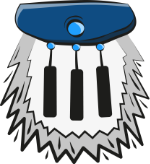Understanding chords, sometimes referred to as triads, is the foundation of learning harmony and harmonic structure. If you listen to any piece of music from Bach to Harry Styles it will have a harmonic framework that repeats.
Once we understand each of the common chords we can join them in such a way that can convey a different mood. This can also help us deepen our musical understanding and appreciation.

In today’s email I want to show you a few things to give a foundation on chords that will get you started.
The 4 main types of chords and their structure
Scale degrees using Roman numerals and associated chords
A common chord progression and 10 pop songs that use the same one
The 4 Main Chord Types
When we think about chords, there are four main ones to be aware of. The major, minor, diminished and augmented. You can see each one in the image below.

Each chord is built up on 2 types of 3rds. Either major 3rds (2 tones) or minor 3rds (1.5 tones). 3rds are what’s known as intervals which is the relationship between two notes. There are a bunch of videos with information on intervals on my YouTube channel.
I won’t go any deeper on this just now. The intent isn’t to go in to too much detail here but if you’ve any questions let me know.
Primary chords
In any given key (C major for example) we have 7 notes and related diatonic chords. Diatonic means they relate directly to that key. Each note has a number associated to it. These can also be know as degrees of the scale and Roman numerals are used to describe them.

The chords that are most frequently used are call the primary chords and they are I, IV, V and sometimes vi.
The reason musicians use Roman numerals is to provide a framework of chords that aren’t dependant on key. We can apply I, IV, V and vi to any key and it would sound the same but at a different pitch.
For instance, a singer might be able to sing a song in a certain key. Then, they go out for a serious party and their voice sounds deeper the next day. We can take the same framework and move it to a lower key to accomodate until the singer recovers.
Common Chord Progressions
There isn’t a lot of originality in music. People have been writing music and songs for centuries. Even though style may vary, there are common chord progressions used all the time.
One example would be I, V, vi, IV. If we were in the key of C, this would mean we use C major, G major, A minor and F major (see the image above). Here are 10 songs that use that very structure.
“Let It Be” by The Beatles: C, G, Am, F
“Hey Soul Sister” by Train: C, G, Am, F
“No Woman, No Cry” by Bob Marley: C, G, Am, F
“Wish You Were Here” by Pink Floyd: C, G, Am, F
“Don’t Stop Believin'” by Journey: C, G, Am, F
“With or Without You” by U2: C, G, Am, F
“Stand by Me” by Ben E. King: C, G, Am, F
“Pompeii” by Bastille: C, G, Am, F
“Fast Car” by Tracy Chapman: C, G, Am, F
“Counting Stars” by OneRepublic: C, G, Am, F
I’m sure all this information leads to more questions. The world of harmony is huge with lots to learn. Understanding the information above gives us a place to start.

